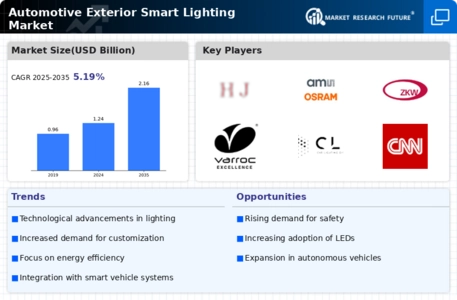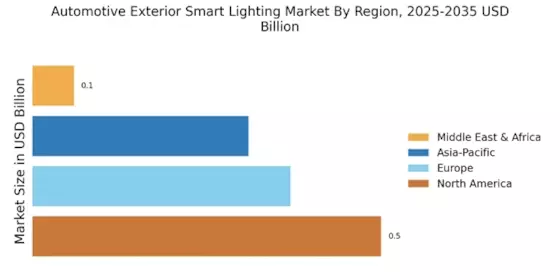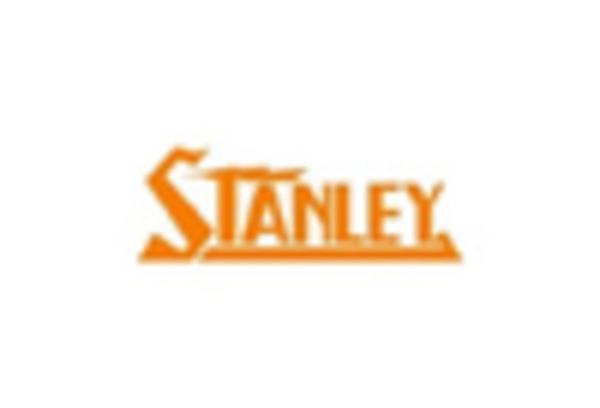Focus on Energy Efficiency
Energy efficiency is becoming a pivotal driver in the Automotive Exterior Smart Lighting Market. As consumers and manufacturers alike prioritize sustainability, the demand for energy-efficient lighting solutions is on the rise. LED technology, known for its low energy consumption and long lifespan, is at the forefront of this trend. Reports suggest that LED lights can consume up to 75% less energy than traditional halogen bulbs, which not only reduces operational costs but also aligns with global efforts to minimize carbon footprints. This focus on energy efficiency is likely to propel the market forward, as automakers strive to meet consumer expectations for environmentally friendly vehicles while adhering to increasingly stringent regulations.
Consumer Demand for Customization
Consumer preferences are shifting towards personalized vehicle features, which is driving the Automotive Exterior Smart Lighting Market. Modern consumers are increasingly seeking vehicles that reflect their individual style and preferences, leading to a demand for customizable lighting options. This trend is evident in the growing popularity of ambient lighting and color-changing LED systems that allow users to modify their vehicle's exterior appearance. Market analysis indicates that the customization segment is expected to grow at a compound annual growth rate of over 10% in the coming years. As automakers respond to this demand, the integration of smart lighting solutions that offer personalization features is likely to become a key differentiator in the competitive automotive landscape.
Integration of Advanced Technologies
The Automotive Exterior Smart Lighting Market is experiencing a notable shift due to the integration of advanced technologies such as LED and OLED lighting systems. These technologies not only enhance visibility but also allow for dynamic lighting patterns that can adapt to driving conditions. The market for LED automotive lighting is projected to reach approximately USD 30 billion by 2026, indicating a robust growth trajectory. Furthermore, the incorporation of smart sensors and connectivity features enables vehicles to communicate with their environment, improving safety and user experience. This technological evolution is likely to drive demand for smart lighting solutions, as consumers increasingly seek vehicles equipped with innovative features that enhance both functionality and aesthetics.
Regulatory Influence on Safety Standards
The Automotive Exterior Smart Lighting Market is significantly influenced by regulatory frameworks aimed at enhancing vehicle safety. Governments worldwide are implementing stringent safety standards that mandate the use of advanced lighting systems to improve visibility and reduce accidents. For instance, regulations may require adaptive lighting systems that adjust beam patterns based on driving conditions. This regulatory push is expected to drive innovation and investment in smart lighting technologies, as manufacturers seek to comply with these evolving standards. The market is likely to see an increase in the adoption of smart lighting solutions that not only meet regulatory requirements but also offer enhanced safety features, thereby appealing to safety-conscious consumers.
Advancements in Autonomous Vehicle Technology
The rise of autonomous vehicle technology is poised to reshape the Automotive Exterior Smart Lighting Market. As vehicles become increasingly automated, the need for advanced lighting systems that communicate the vehicle's intentions to other road users becomes paramount. Smart lighting solutions, such as dynamic turn signals and adaptive headlights, are essential for enhancing safety and ensuring smooth interactions between autonomous vehicles and pedestrians or other drivers. Industry forecasts suggest that the market for smart lighting in autonomous vehicles could witness substantial growth, potentially reaching USD 5 billion by 2030. This trend indicates a significant opportunity for manufacturers to innovate and develop lighting systems that cater to the unique requirements of autonomous driving.


















Leave a Comment